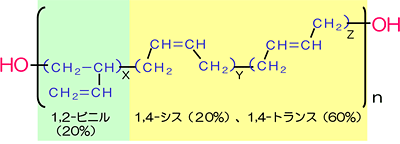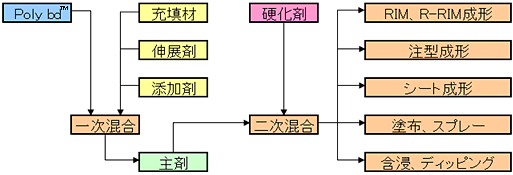Hydroxyl Terminated Poly butadiene™ (hydroxyl-terminated liquid polybutadiene)
"Hydroxyl Terminated Poly butadiene™" is a polybutadiene-type liquid polymer with a highly reactive hydroxyl group at the end of the molecule. Like conventional polyurethane, it easily reacts and cures with isocyanates, forming a good urethane-based elastomer (rubber elastic body).
This elastomer has a butadiene structure with 1,4-bond main chains, so it has excellent water resistance, chemical resistance, electrical properties, and cold resistance. In addition, reinforcement with carbon black or white carbon and oil spreading with process oil, asphalt, etc. are possible.

Features of Hydroxyl Terminated Poly butadiene™
-
good rubber elasticity
It has approximately 80% 1,4 bonds, making it an excellent rubber elastic material. -
Excellent cold resistance
It has excellent cold resistance as the embrittlement temperature of the cured product is below -70℃. -
Exceptional water resistance
Since the main chain does not contain ether or ester, it has excellent water and chemical resistance. -
Effective reinforcement and oil spreading possible
Reinforcement/increase with carbon black, various fillers, and oil expansion with process oil, asphalt, etc. are possible. -
Excellent electrical properties
It has electrical insulation and dielectric properties comparable to those of epoxy resin and silicone rubber, and is characterized by low temperature dependence. Furthermore, it has low moisture permeability, low water absorption, and low thermal stress, so it can withstand thermal cycle tests (-55℃ to +130℃). -
Excellent workability
Since it is a liquid, it is easy to process and can be easily mechanized, automated, and continuous, and it can be cast and processed on-site without sacrificing the elasticity and strength of rubber, increasing work efficiency. Taking advantage of these features, it is used in a variety of fields as a new rubber elastic material that can replace conventional ether-based polyurethane, ester-based polyurethane, silicone, epoxy, etc.
Hydroxyl Terminated Poly butadiene™ processing
Since the initial state is liquid, it is easy to process and can be used with various molding methods.

Formulation examples and physical properties of cured products
| Basic composition | Oil-extended formulation | Asphalt extension compound | Contains short chain diol (1) | Contains short chain diol (2) | Inorganic filler reinforcement | R-15HT basic formulation | |
|---|---|---|---|---|---|---|---|
| Formula (parts by weight) | |||||||
|
Hydroxyl Terminated Poly butadiene™ R-45HT |
100 | 100 | 100 | 100 | 100 | 100 | - |
|
Hydroxyl Terminated Poly butadiene™ R-15HT |
- | - | - | - | - | - | 100 |
| Catalyst (dibutyltin dilaurate) | 0.05 | 0.05 | 0.05 | 0.05 | 0.05 | 0.05 | 0.05 |
| liquid modified MDI | 12.3 | 12.3 | 12.3 | 24.6 | 24.6 | 12.3 | 27.8 |
| Aroma process oil | - | 100 | - | - | - | - | - |
| 60/80 straight asphalt | - | - | 100 | - | - | - | - |
| Short chain diol (aniline type) | - | - | - | 8.6 | - | - | - |
| Short chain diol (bisphenol A type) | - | - | - | - | 16.6 | - | - |
| precipitated calcium carbonate | - | - | - | - | - | 100 | - |
| Physical properties of cured product | |||||||
| Tensile strength (MPa) | 1.7 | 1.2 | 2.0 | 8.6 | 7.9 | 5.3 | 4.9 |
| 100% modulus (MPa) | 1.2 | 0.6 | 0.6 | 3.3 | 3.5 | 2.1 | 1.9 |
| stretch(%) | 180 | 300 | 500 | 315 | 275 | 640 | 275 |
| Tear strength (N/mm) | 6 | 4 | 8 | 25 | 24 | 25 | 14 |
| Hardness (Shore A) | 48 | 36 | 41 | 74 | 75 | 65 | 60 |
| concept | - |
Lower hardness High elongation Initial viscosity decrease Cost reduction |
Lower hardness High elongation Cost reduction |
High strength | High strength |
High strength Cost reduction |
Initial viscosity decrease |
-
Mixing conditions: [NCO]/[OH]=1.05
Curing conditions: Press 120℃ x 1 hour + Post curing 70℃ x 15 hours
Physical property measurement conditions: JIS K 6301 compliant -
The data listed on this page are representative examples of measured values under specific conditions, and are not standard or guaranteed values.
-
Please note that the contents of this page are subject to change without notice due to improvements.
Technical data
If you would like more detailed information, please use the inquiry form.
-
When making an inquiry, please select "Petrochemical" as the inquiry category.